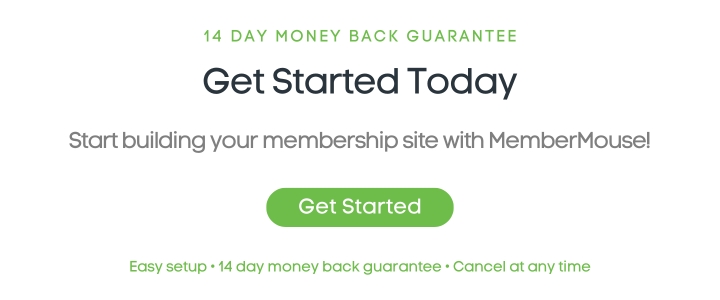How To Stay Focused & Grow Your Membership After You Launch
Congrats! 🥳
You just launched your membership site, subscription platform, or online course.
After months of planning, late nights, and heroic-level content creation, the dream you've held in your mind is finally a reality for the whole world to see. Time to pop the Dom Perignon (or Martinelli's) and decompress from all those WordPress tutorial videos still echoing through your mind.
Figuring out how to fill your site with an engaged tribe of superfans can wait until tomorrow morning. Plus, it'll only take a few Instagram stories, Facebook posts, and email “blasts” to get everyone in the doors, right?
One can hope…
But unless your name is Amy Porterfield, you should probably prepare for things to not work out quite like that. Because even though it feels like the “hard part” of your journey is over, the truth of the matter is that you've only just begun.
As exciting and energizing as the launch phase is, it's kind of a false summit that tricks you into thinking it's all downhill from here. Though at best, you've only just reached the halfway point.
We know… we know…
We're killing the vibe of your launch party faster than that one friend who insists on serenading you with their acoustic rendition of Wonderwall.
The only reason we're telling you all this is because we want to make sure you're ready to forge ahead on the path to a profitable membership after the champagne wears off in the morning.
And to help you navigate the post-launch leg of your journey, we turn to membership site expert Ali Jafarian. He's the founder & CEO of MemberDev. Over the past 7 years, he and his team have built over 30 high-performance membership sites in nearly every market imaginable.
We recently invited Ali onto our podcast to talk about everything you need to know after launching your membership site. In this article, we pull out some of the golden nuggets he shared in that conversation that we hope will help you tackle what comes after your launch.
We'll let Ali take it from here.

Ali Jafarian
First Things First: Create A 6-12 Month Plan
Hopefully this is obvious, but the first thing you should do is have a plan for what to do after your membership launch.
Your membership site is up and running. So, you want to have some method – usually a 6- to 12-month plan – to move through the first few key stages of growth.
Ideally you have at least a 12-month plan to move from a brand-new site, to your first few customers, to slow growth, and ultimately to the acceleration phase. That’s when you have money coming in, you’ve got traction, and you’re wondering how you can get to the next level.
I can’t stress enough how essential it is to have a plan and stick to it.
“With a membership site, you cannot know what's going to happen when you really get in there, build it, and then launch it. There's going to be change. Your ability to embrace that change is really important.”
Don’t Skip The Early Adoption Phase
A lot of people want to skip the “early adoption” phase and move directly into the “sales & growth” phase.
What do I mean by that?
Well, it’s really important to get a few early adopters into your site. You need people in there using it and giving you feedback about what they like and don’t like. The feedback you get from them is what will help you refine your offering and ensure you’re ready to bring in people at scale.
Sometimes the best way to get people in there is to give away your membership for free. Think of these people as your “beta testers.” While they may not be paying your money for your membership, they’re giving you something far more valuable at this stage of your business: feedback.
I recommend that you stay close to this cohort of early adopters. Have a direct email address where they can contact you to share what they think about your membership. You can even spend a bit of time with them on a Zoom call to hear about what they love about your site, what’s confusing, and what might not even be necessary at all.
These are the people who will help you shape and define the true value you bring to the market. You’ll know them by name. They’ll come up in stories you tell in your marketing. I get that we all have big plans and elaborate pricing strategies for our businesses. But the fact of the matter is that none of that matter until someone completes checkout and you get the notification that the money hit your back account.
Your early adopters are the ones who truly validate that whatever it is you’ve launched is actually worth paying for. My best suggestion for you at this stage of your business is to stay close and cultivate a small tribe of these people.
On a more tactical note, I’d recommend paying close attention to what this initial cohort of users does on your site. What pages do they visit most? Where do they spend the most time? This is really important because it’ll help you make informed decisions about where to devote your energy. It can be really tempting to go full-steam ahead and say: “Hey, we’ve got to get all these different tools and set up automations.” When in reality, that can be a huge waste of time, effort, and money.
You’ll learn so much from just watching how people actually behave on your site and asking simple questions like “What can we do better?” or “What would you like to see in the coming months?”
Once you complete this stage, you’ll move into the phase where you’re making a few thousand dollars per month. Then you have a different set of decisions to navigate.

Double Down After Your First Organic Sales
As you move into the next stage of your journey, you’ll start to see some consistent sales and revenue come in. You’ll likely be in the low thousands per month: $1,000, $2,000, and maybe even up to $5,000 per month. At this point, you’ve proven that people want what you have to offer and it’s valuable to them. But, you’re not yet at the phase you’re ready to grow a team and develop a bunch of sophisticated processes and automations.
How do you get to this phase in the first place?
Remember that small tribe of early adopters you cultivated? It’s time to go back to them and do a bit of reverse engineering. You can send out a survey to your first group of customers and ask them a few questions like these:
👋 “Where did you come from?”
🤔 “How did you hear about our membership?”
🔎 “Was there one place in particular you remember first seeing us?”
Once you have answers to these questions, the next step is simple. You simply go out and do more of that until it doesn’t work anymore. For example, let’s say that you’ve built up a sizable following on Instagram. There’s a few hundred people who regularly engage with you there on that platform.
After you conduct the research with your first set of customers, you realize that five of your early adopters were people who follow you on Instagram, watch your stories, and comment on your posts. It becomes clear that whatever you’re doing there is working. So, it’s time to either exponentially increase what you’re organically doing on that platform or tap into Facebook ads to reach more people like your current engaged follower base. This is a surefire way to grow your membership. Not only is it relatively low risk, it’s also proven to work because you’ve got the data to back it up.
“You can have all the plans in the world and ideas for elaborate pricing strategies. None of that matters until someone actually completes your checkout and you get the notification that the money hit your bank account.”

Remember To Do A “Strengths Check”
As you move through these initial post-launch growth stages, it can be easy to get caught up in the busyness of day-to-day tasks and planning. If your nose is only ever at the grindstone, you run the risk of straying off course and delaying meaningful progress. That’s why it’s critical you routinely do something I call a “strengths check-in.”
Bring some self-awareness to yourself and your team by asking, “Where are we strong?” In other words, if you’re the sort of person who can crank out content all day long, do that. Or, if you’ve got some engineering chops, then double down on that.
When you do this, it helps you stay focused and identify the things you’re not so good at. From there, you can outsource the areas of your business that feel like a burden and slow you down from working on what really matters. You want to stay in your “zone of genius” and find people who can help you fill the gaps.
Resist The Pull Towards Complexity
Simplicity is a topic that’s near and dear to my heart. It’s something that I continue to be a student of. Frankly, it slaps me in the face over and over again because I’m really a technician at heart. I’m wired to think about the future make things unnecessarily complex.
The reason complexity is so dangerous is that it affects everyone involved in your membership. The more complicated you make things, the more you, your team, your customers, and even your prospects are impacted.
For example, it’s easy to create a vision for a simple product or a simple membership site. Then, it becomes much easier to execute and build this vision. When it’s done, it is much simpler to explain it to your prospects and get people to actually sign up.
On the contrary, a more complex membership site inherently becomes a more complex offer. It’s just the opposite. It takes longer to build and becomes harder to tell people about. With complexity, everything boils down to the word more. More this, bigger that, extra this, etc. When you’ve built as many membership sites as I have, you generally find that what you really want is less.
Stay Consistent After You Launch
The last and most important point of all is consistency. I can’t tell you how many people fail because of their lack of consistency. During the first month or two post-launch, they’re amped and excited. They’re bursting out of the gate and ready to take on the world. For some reason, they lose steam and their project eventually dies.
This is true for membership sites, online courses, and life in general. It’s been such an important lesson that I’ve learned as an entrepreneur. I will always emphasize the power of consistency with anyone I work with. At the end of the day, consistency always pays off in some form or another. If you stay the course and put out an ongoing and even extraordinary effort, you will see results.

Final Thoughts
Thanks for sticking with us as we outlined the strategy you can use to successfully navigate the post-launch phase of your membership, subscription, or online course business.
If you enjoyed what you learned in this article, we have a feeling you'll love the two podcast episodes we've recorded with Ali:
→ Everything You Need To Know Before Starting A Membership Site
→ Everything You Need To Know After Starting A Membership Site
If you have any questions, comments, or any other thought you’d like to share with us, leave us a comment below and join our conversation.
Now we’ll let you get back to your post-launch party. Hopefully your bubbly hasn’t gone flat.
Matt Brown
Over the past 6 years, Matt Brown has worked closely with some of the world's most successful membership and online course entrepreneurs. He's seen first hand what works – and what doesn't – when it comes to starting, building, and growing online businesses. On top of that, Matt was responsible for screening all the guests we've had on the Subscription Entrepreneur podcast. This allowed him to hear the best membership marketing and growth strategies from top authors and experts. Now, he shares everything he learns with you here on the MemberMouse blog. Subscribe today so you can discover cutting-edge strategies that can help you grow your membership, subscription, and online course business.
 Blog
Blog Podcast
Podcast Support
Support Customer Login
Customer Login










